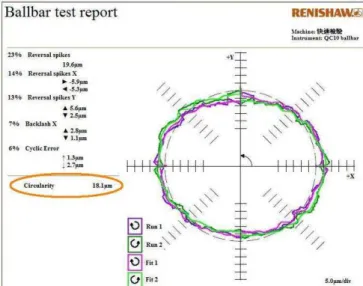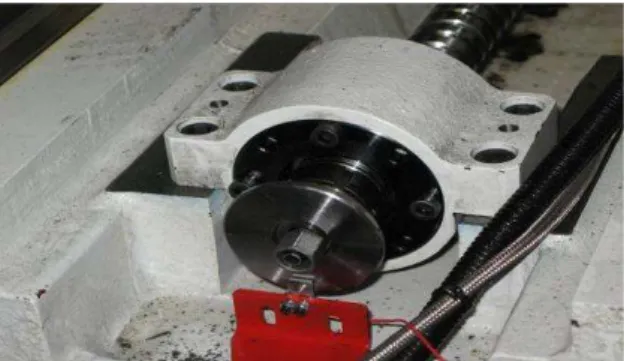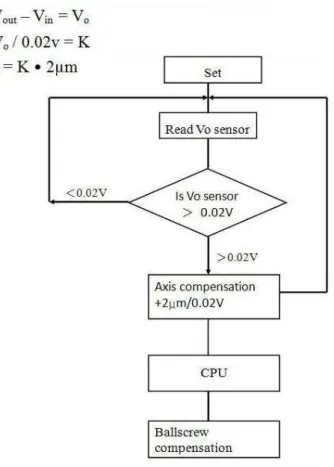Abstract—Thermal growth effects the reliability and accuracy of a machine tool, especially, as it relates to the High Speed Machining (HSM) technology. When axis speeds increase, the effect of thermal expansion of ballscrews will create large positional errors of the axes. In this paper, a piezo-integrated actuator and a load sensor are placed on the machine ballscrews, and the feedback from this arrangement becomes an ideal source for compensation of backlash and thermal expansion. This smart unit provides excellent performance of tolerance, the roundness test report reduced from 18.1µm to 10.00µm, and large cost savings in the manufacture of the machine tool.
Index Terms—Thermal growth, HSM, Compensation
I. INTRODUCTION
1-1 Background
Ballscrew thermal compensation has been proven to be one of the most effective methods to ensure the accuracy of machine tool production [1]. However, two major obstacles limit this application, the effectiveness and reliability of the thermal gathering device, along with the lengthy calibration task that the compensation must be applied [2]. As it becomes difficult to obtain accurate temperature readings from any given source and its' related components, a new solution to the approach of ballscrew compensation is needed to overcome the deficiencies of the current methods.
Most of the tensioning device is provided for the ballscrew. The backlash compensation of a machine tool is set under a no-load situation, and an experienced machine tool technician can extrapolate a good compensation value for a loaded condition with reasonable accuracy. But there still can be up to 12 – 18µm tolerance of roundness [3-4]. This is typically acceptable, but never be perfect in some applications, such as high grade mold and die work, Automobile industries, aerospace etc., these require a higher level of accuracy [5-8]. Fig. 1 shown a Ballbar test report of a traditional pretension placed.
Manuscript received January, 2009.
Ching-Feng Chang is with the Department of Electrical Engineering, National Changhua University of Education, Changhua City 500, Taiwan (corresponding author to provide phone: +886 4 2560 3759; fax: +886 4 2560 3769; (e-mail:pauljfc@ms29.hinet.net.).
Chih-Chung Wang, is with Department of Electrical Engineering, National Changhua University of Education, Changhua City 500, Taiwan (e-mail: wangcc@cc.ncue.edu.tw).
Chao-Shui Lin is with Department of Electrical Engineering National Changhua University of Education, Changhua City 500, Taiwan (e-mail:
libjoyce@cc.ncue.edu.tw).
. Ching-Yi, Chao is with Department of Electrical Engineering, DAYEH University, Changhua City 500, Taiwan (e-mail: Jackson@tmg.com.tw).
Tsair-Rong Chen is with Department of Electrical Engineering National Changhua University of Education, Changhua City 500, Taiwan (e-mail: ietrchen@cc.ncue.edu.tw).
1-2 Ballbar test
This test was done on a Challenger high speed vertical machining center. This machine utilized a linear construction way to meet the higher speed movement application. A ballbar test without thermal compensation is shown in Fig. 1.
Fig. 1. Ballbar test report of a traditional design. In Fig. 1, a tolerance of circularity is 18.1µm, which was achieved with a Hollow Shaft Oil Cooled ballscrew system, and pretention placed.
1-3 Ballscrew cooling system
Many recent technology uses a cooling system for the ballscrews. A hollow shaft ballscrew is used on the machine. An external chiller unit is plumbed to ballscrew and circulates chilled oil through the screw to maintain a constant temperature [9]. Figs. 2 and Fig.3 show the design of a chilled ballscrew and the joint unit. Fig. 4 shows the accuracy performance of a chilled ballscrew. It gives a nearly 3µm tolerance of a travel in movement distance for 640mm, and the curve shows tolerance across zero point (from plus to minus). This curve tells that the tolerance is far from linear. Although it’s pretention loaded and oil chilled.
Fig 2. Hollow ballscrew.
A Theory of Ball-screw Thermal Compensation
Fig. 3. Joint for hollow ballscrew.
Fig. 4. Laser sample of ballscrew tolerance.
The chilled ballscrew design is effective, but there are several issues that make this model less than ideal value. Coupling issues from the chiller to the ballscrew are unreliable, such as leakage that can be mixed with cutting oils, it will diminish tool life and cause environmental issues [11]. Moreover, the overall costs of the chiller unit and maintenance remain high as well.
1-4 The cost study of chiller unit
Cost considerations of a chiller unit, such as the expensive joint at each ballscrew, the hollow shaft ballscrew cost of 15% - 20% more than a traditional ballscrew, and the chiller unit itself being an expensive item. Service costs is also a large issue with this design. The chiller design will also require experience technician to do properly temperature settings to maintain even temperature control [12]. Cooling
Table 1
Component cost of chiller unit Item Hollow Ballscrew with chiller Cost US$
1 Hollow Ballscrew 3 x 100.00 2 Joint & Parts 3 x 250.00
3 Chiller 200.00
4 Piping 120.00
Total 1970.00
II. MODEL DEVELOPMENT &SIMULATION
2-1 Mechanical layout and load control
An updated technique by putting one measuring unit has been placed at the end of the ballscrew as shown in Fig. 5. Pretension of ballscrew has been removed, which is to ensures that the thermal growth approach is applied to one direction only [13-17]. This will ensure that the PLC compensation can be applied to the entire extention of the ballscrew.
In this proposed model, a Displacement Measurement Meter is placed at the end of the ballscrew [18-20], see Fig. 6. The feedback from this unit will be evaluated for compensating the backlash of the ballscrew. This smart solution offers excellent performance and considerable cost savings in the manufacture of the machine.
Fig. 5. Free end ballscrew with Sensor layout.
Fig. 6. Ballscrew with a measurement sensor. 2-2 Eddy current
V
L=
L
di
dt
……….(1)where
V
L is induced voltage in voltL is the value of inductance in henries.
dt
di
is the rate of changes of current in Amp. per sec.
It is extremely important to know the characteristic of the depth of penetration and the density of current. Fig. 7 shows the penetration. It gives a narrow range of area to be measured.
Depth
Density Standard Depth
of Penetration
Fig.7. Penetration of Foucault current. This penetration depth is given by:
μσ
π
δ
f
1
≈
……….(2)where
δ is the depth of penetration (mm). f is the test frequency (Hz)
µ is the magnetic permeability (H/min.)
σ is the electrical conductivity. 2-3 Logical concept
The parameter has been set for allowing a ballscrew compensation of 2µm when the output voltage changes +0.02V. Since the ballscrew will grow only when the machine starts to run, so the compensation is set ‘+’ only, and the logic chart is shown in Fig. 8.
Fig.8. Logic chart. 2-4 Voltage amplifier
A simplified model of the voltage amplifier is shown as Fig. 9 [21].
Vi
i
TR C1 R1
R3
0
V -A
C2 R2
Fig. 9. Simply voltage amplifier. The Foucault current equation is given as below:
1
sin
i i
V
V
i
R
R
ω
t
=
=
……….(3)where
ω
t
is the phase at time t.(
)
0
1 2 2
1
1
1
i
V
V
C
C
AC
= ×
+
+
………(4)
Fig. 10 (a) simulator
Fig. 10 (b) measured voltage.
Fig. 11 shows the output response of the current and voltage of the amplifier. It shows no timing delay. Thus, the amplifier meets the requirement.
Fig. 11. Voltage and current responses.
III. EXPERIMENTAL RESULT 3-1 Ballbar Set-up
Fig. 12 show Ballbar test on a Challenger brand Vertical Machining Center. The new model save a lot of assembly time as there is no ballscrew pretention placed. The free end
Fig. 12. Ballbar set-up 3-2 Ballbar test
Fig. 13 show a roundness value of 10µm, which is measured from the new model, it shows a big improvement of the tolerance.
Fig. 13 Ballbar test report of the proposed new model.
IV. CONCLUSION
The new model utilizing a Displacement Measurement Meter performed considerably better than traditional chilled ballscrew systems. From the test reports, circularity test results improved from 18µm to 10µm. Additionally, this new model offers considerable cost savings over the traditional hollow screw systems. Table 2 shows a cost saving of US$1,869.00.
Table 2
REFERENCES
[1] J.S. Chen and G. Chiou, “Quick testing and modeling of thermally induced errors of CNC machine tools”, Int. J. Mach. Tools Manufact, vol.35, no.7, pp.1063-1074, 1995.
[2] James Wong, Temperature Measurements Gain from Advances in High-precision Op Amps, Electronic Design, 15 May 1986.
[3] P.C. Tseng, “A Real-Time Thermal Inaccuracy Compensation Method on A machining Center,” The International Journal of Advanced Manufacturing Technology, Vol. 13, 1997, pp. 182 - 190.
[4] W.Y. Hsu and J.S. Chen, “Error Analysis and Auto-Calibration for a Cartesian-Guided Tripod Machine Tool,” International Journal of Advanced Manufacturing Technology, Vol. 24, Number 11-12, 2004, pp 899 – 909.
[5] Siemens AG, “Tool and Mold making – Motion Control System,” Automation Technology, Industrial Automation News for the Americas, Third Quarter, www.automation.Siemens.com, 1998. [6] A. Donmez, “Smart Machining Systems,” Manufacturing Engineering
Laboratory, National Institute of Standards and Technology, www.mel.nist.gov/proj/sms.htm, 2005.
[7] P. Frederickson and D. Grimes, “Increasing Torque For A High Speed Spindle,” Features Article on Modern Machine Shop, MMSonline.com 2003.
[8] Kennametal Inc., ”Dodeka Face Mills for Maximum Milling Performance for High Performance in Carbon and Stainless Steels,” www.kennametal.com, 2008.
[9] Precision ballscrew div. of PMI, “High Lead Ballscrew”,www.pmi-amt.com/en 2008
[10] Buffalo Machinery Company Limited, “Inspection Report of Vertical Machining Center, V-Series” Version III, www.buffalo.com.tw,2008 [11] J.S. Chen, K.C. Chen, Z.C. Lai and Y.K. Huang, “Friction
Characterization and Compensation of Linear-Motor Rolling-Guide Stage,” International Journal of Machine Tools and Manufacture, Vol. 43, 2003, pp 905-915.
[12] Buffalo Machinery Company Limited, “General Design Guide for Metal Working Machine Tools” Version IV,
www.buffalo.com.tw,2008
[13] P.C. Tseng and Chen S.L., “The Neural-Fuzzy Thermal Error Compensation Controller On CNC Machining Center,” The Japan Society of Mechanical Engineering, JSME, SCI, ISSN: 1340 – 8062, Series C, Vol. 45, No. 2, 2002, pp. 470 – 478.
[14] J.S. Chen, “A Study of Thermally Induced Machine Tool Errors in Real Cutting Conditions,” Int. J. Mach. Tools Manufact, Vol. 36, No. 12, 1996, pp. 1401 – 1411.
[15] J.S. Chen, et al, “Real-time Compensation for Time Variant Volumetric Error Compensation,” ASME Winter Annual Meeting, Dec. 1991. [16] Gunter, Spur., “Thermal Behavior Optimization of Machine Tools
Using Design Measures and Compensatory Techniques,” Proceeding of the 4th International Machine Tool Engineers Conference (IMEC), Nov. 1990.
[17] ]P.C. Tseng, “A Real-Time Thermal Inaccuracy Compensation Method on A machining Center,” The International Journal of Advanced Manufacturing Technology, Vol. 13, 1997, pp. 182 - 190. [18] Waycon Positionsmesstechnik Gmbh, “Eddy Current, Series TX”,
www.waycon.de, 2005.
[19] NDT Resource Center, “Depth of Renetration & Current Density”, http://www.ndt-ed.org, 2008
[20] ACE CORP, “PU-03A*291-102 Sensor”, Kanagawa Japan, 2006 [21] C. Kitchin and L. Counts, A Designer’s Guide to Instrumentation Amplifiers, Third Edition, Analog Device INC., North Wood MA, 2006.
[22] T.L. Floyd, “Electronics Devices,Conventional Current Version,” Seventh Edition,Pearson Education, Upper Saddle River,New Jersey, 2005.
[23] N. Mohan, T.M. Undeland and W.P. Robbins, Power Electronics, Third Edition, New Jersey, 2003.
[24] Ramon Pallas-Areny and Joan G. Webster, Sensors and Signal Conditioning, John Wiley, New York, 1991.


